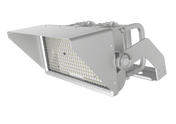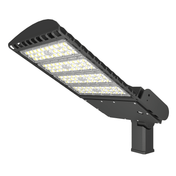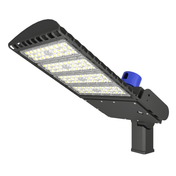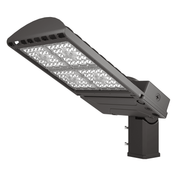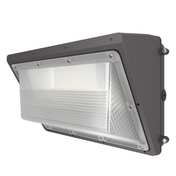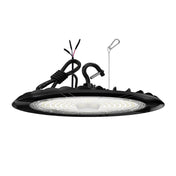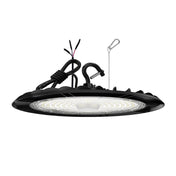Introduction
The global LED area lighting industry stands at a crossroads in 2024, with contrasting dynamics reshaping its landscape. While the overall LED lighting market faces headwinds—with global output value declining 4.2% to $56.06 billion according to TrendForce—specific segments like smart outdoor lighting and solar-integrated solutions are experiencing robust growth. This dichotomy highlights a critical industry shift: as general lighting commoditizes, innovative LED area lights tailored for commercial, industrial, and smart city applications are emerging as the new growth engines. In this report, we analyze the key trends, technological breakthroughs, and real-world applications defining the LED area lights market in 2024.
Market Dynamics: Contrasting Trends in LED Area Lighting
The LED lighting industry’s "two-speed" growth is evident in recent market data. While leading manufacturers like Signify reported a 9.1% year-over-year decline in LED lighting revenue in 2024’s first half, specialized segments tell a different story. The industrial and commercial LED lighting market is projected to grow by $17.99 billion by 2029 at a CAGR of 8.5%, driven largely by demand for advanced area lighting solutions.
This divergence stems from two factors:
- Consumer Downgrading in General Lighting: Budget-conscious buyers prioritize low-cost options in mature segments, pressuring manufacturers into price competition.
- Premiumization in Specialized Applications: Commercial and industrial clients increasingly invest in high-value LED area lights with smart features, energy efficiency, and durability—willing to pay premium prices for long-term savings.
Notably, smart lighting systems have bucked the downward trend, growing 17.6% in 2024 as businesses seek IoT-integrated solutions for their outdoor and industrial spaces. This shift underscores a broader industry transition from commodity products to technology-driven solutions.
Technological Breakthroughs Reshaping LED Area Lights
2024 has witnessed significant innovations in LED area lighting, with manufacturers focusing on versatility, intelligence, and sustainability.
Adjustable Design: One Fixture, Multiple Applications
LEDVANCE’s award-winning Opti-Select Area Light, recognized in the 2024 IES Progress Report, exemplifies this trend. The fixture allows field-adjustable light distribution (Type III, IV, V) without lens changes, reducing inventory needs by consolidating 27 SKUs into one product. Its features—including selectable color temperatures (3000K/4000K/5000K), 109 lumens per watt efficiency, and integrated Bluetooth mesh controls—address the core needs of commercial operators seeking flexibility.
AI Integration for Predictive Maintenance
Industrial-grade LED area lights now incorporate AI-driven diagnostics for hazardous locations like oil rigs and chemical plants. These systems monitor performance anomalies in real-time, triggering maintenance alerts before failures occur. In warehouse settings, AI-powered sensors analyze occupancy patterns to adjust brightness dynamically, cutting energy use by 20-30%.
Solar Integration: Off-Grid Efficiency
Solar-powered LED area lights have become viable alternatives to grid-connected systems, especially in remote locations. A case study of a 12,000 sq ft grocery store parking lot demonstrated that solar LED solutions eliminated $8,000 in trenching and cabling costs while meeting IES illumination standards (1.61 footcandles) . Modern solar fixtures with lithium-ion batteries now provide reliable operation for 3+ cloudy days, overcoming previous limitations.
Durability Enhancements
Manufacturers are prioritizing rugged designs for harsh environments. Leading products now feature IP67 waterproof ratings, 10kV surge protection, and operating temperatures ranging from -40°F to 122°F, ensuring reliability in extreme conditions.
Real-World Applications: ROI Stories from 2024
Practical implementations of advanced LED area lights are delivering measurable returns across sectors:
Commercial Parking Lots: Cost Savings & Safety
A retail parking lot upgrade using 50W solar LED area lights reduced operational costs through:
- Elimination of electrical trenching expenses ($8,000 for three poles)
- 100% renewable energy operation, cutting utility bills to zero
- Improved visibility (1.61 footcandles) exceeding safety standards
- Reduced maintenance needs compared to HPS systems
Industrial Warehouses: Efficiency & Productivity
Large-scale facilities adopting 200- 400W high-bay LED area lights report:
- 50-70% lower energy consumption vs. traditional lighting
- 10-15% productivity gains from better light quality (4000K-6500K)
- Reduced downtime through smart maintenance alerts
- Compliance with DLC 5.1 standards, qualifying for utility rebates
Smart Cities: Multi-Functional Infrastructure
Municipal deployments increasingly use LED area lights as IoT hubs, integrating:
- Environmental sensors (air quality, temperature)
- Motion detection for adaptive lighting
- Data collection for traffic management
- Public Wi-Fi hotspots, maximizing infrastructure value
Regulatory & Market Forces Shaping Adoption
Policy drivers and market pressures are accelerating LED area light adoption:
Energy Efficiency Mandates
Stricter regulations worldwide—including the EU’s Ecodesign Directive and U.S. DOE standards—are phasing out inefficient lighting, creating urgency for LED upgrades. DLC certification has become a de facto requirement for commercial projects, ensuring energy efficiency and eligibility for rebates.
Sustainability Goals
Corporate and municipal carbon reduction targets favor LED area lights, which reduce emissions through lower energy use and longer lifespans (50,000-100,000 hours vs. 10,000-20,000 for HPS) . Solar-integrated models further align with net-zero objectives.
Economic Pressures
High energy costs and inflation are pushing businesses to prioritize long-term savings. A 10-fixture parking lot upgrade to LED typically pays back in 3 years, with 10+ years of subsequent savings.
2025 Outlook: Emerging Trends to Watch
The LED area lights market is poised for further transformation, with three key trends on the horizon:
-
EV Charging Integration: LED poles with built-in electric vehicle charging stations are entering trials in Europe, turning lighting infrastructure into mobility hubs.
-
Health-Focused Design: Following the success of "emotional lighting" in indoor spaces, manufacturers are developing area lights with circadian rhythm support for outdoor work environments.
-
Trade Policy Impacts: Potential tariff changes in 2025 may shift supply chains, with regional manufacturing gaining importance for cost and compliance.
Additionally, vertical farm expansion is creating new demand for specialized LED area lights, with the Plant lighting market projected to grow 6.8% annually through 2025.
Conclusion
The LED area lights industry in 2024 demonstrates resilience through innovation, as manufacturers navigate general market weakness by focusing on high-value segments. Smart features, solar integration, and application-specific designs are no longer niceties but necessities, driven by regulatory demands, sustainability goals, and economic pressures.
For businesses considering upgrades, the path forward is clear: prioritize certified, adaptable fixtures with smart capabilities to maximize ROI. As demonstrated by successful case studies, the right LED area lights deliver not just illumination but operational efficiency, safety enhancements, and future-ready infrastructure.
The industry’s future belongs to solutions that transcend basic lighting—those that serve as intelligent, multi-functional platforms supporting the cities, businesses, and communities of tomorrow.


